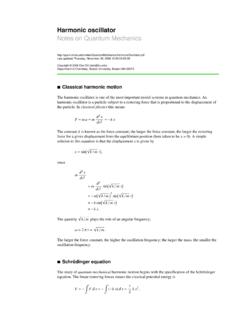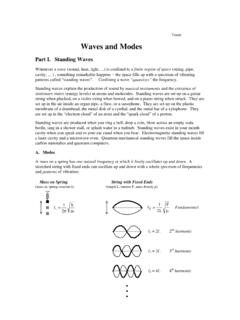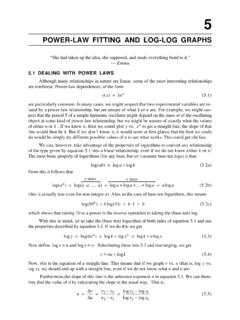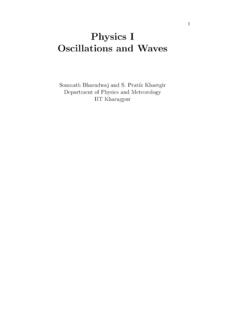Transcription of Derivatives of Trigonometric Functions
1 Derivatives of Trigonometric FunctionsBefore discussing Derivatives of trigonmetric Functions , we should establish a few important iden-tities. First of all, recall that the Trigonometric Functions are defined in terms of the unit , if we draw a ray at a given angle , the point at which the ray intersects the unit circlewill be given by (cos( ),sin( )). That is, cos( ) is thex-coordinate of the point, and sin( ) is they-coordinate. If we connect this point to thex-axis, we can see there is an inscribed triangle, withbase cos( ), height sin( ), and hypotenuse 1. Using the pythagorean theorem that the sum of thesquares of the other two sides is the square of the hypotenuse, we find thatsin2( ) + cos2( ) = 1 This is perhaps the most commonly used and most useful of the Trigonometric identities. If wedivide both sides of the equation by cos2( ) we find1 + tan2( ) = sec2( )If we divide both sides of the equation by sin2( ) we find1 + cot2( ) = csc2( )Keeping these identities in mind, we will look at the Derivatives of the Trigonometric have already seen that the derivative of the sine function is the cosine function.
2 Through a verysimilar we can find that the derivative of the cosine function is the negative sine function. Thus,ddxsin(x) = cos(x)andddxcos(x) = sin(x)It is useful to look at the graph of a function and its derivative together, to see just how muchinformation is contained in the derivative. Notice that at the peaks of the sine function, the cosinefunction is 0. This is because the line tangent to the sine function is horizontal at these the peaks of the cosine function (the derivative of sine) the sine function crosses the x-axis -these are the points where the sine function has the greatest slope, or is changing the most graphs of these Trigonometric Functions also give us a clue as to which derivative contains thenegative sign. Atx= 0, sin(x) is increasing, and cos(x) is positive, so it makes sense that thederivative is + cos(x). On the other hand, just afterx= 0, cos(x) is decreasing, and sin(x) ispositive, so the derivative must be sin(x).
3 Example 1 Find all Derivatives of sin(x).SolutionSince we know cos(x) is the derivative of sin(x), if we can complete the above task, thenwe will also have all Derivatives of cos(x).ddxsin(x) = cos(x)gives us the first derivative of the sine (x) =ddxcos(x) = sin(x)gives us the second derivative. Alsod3dx3sin(x) = ddxsin(x) = cos(x)Finallyd4dx4sin(x) = ddxcos(x) = sin(x)Now we can see that the fourth derivative of sin(x) is sin(x), so we can easily enough find anyderivative of the sine function as follows. Suppose we want to find thenthderivative of sine. Allwe need to do is dividenby 4, and look at the remainderr. If we take therthderivative of sine, itwill be exactly the same as taking thenthderivative, as every four Derivatives will simply return usto the original result of the sine function. Applying this principle, we find that the 17thderivativeof the sine function is equal to the 1stderivative, sod17dx17sin(x) =ddxsin(x) = cos(x)The Derivatives of cos(x) have the same behavior, repeating every cycle of 4.
4 Thenthderivative ofcosine is the (n+ 1)thderivative of sine, as cosine is the first derivative of of the Derivatives of sine and cosine allows us to find the Derivatives of all other trigono-metric Functions using the quotient rule. Recall the following identities:tan(x) =sin(x)cos(x)cot(x) =cos(x)sin(x)sec(x) =1cos(x)csc(x) =1sin(x)Example 2 Find the Derivatives of tan(x), cot(x), csc(x), and sec(x).SolutionWe can find all of the above Derivatives using the quotient rule and the Derivatives ofsine and cosine. Starting with tangentddxtan(x) =ddxsin(x)cos(x)=cos(x) cos(x) sin(x)( cos(x))cos2(x)=cos2(x) + sin2(x)cos2(x)=1cos2(x)= sec2(x)and moving to cotangentddxcot(x) =ddxcos(x)sin(x)=sin(x)( cos(x)) cos(x) sin(x)sin2(x)= sin2(x) cos2(x)sin2(x)= 1sin2(x)= csc2(x)next cosecantddxcsc(x) =ddx1sin(x)=sin(x) 0 1 cos(x)sin(x)2= cos(x)sin(x) 1sin(x)= cot(x) csc(x)and finally secantddxsec(x) =ddx1cos(x)=0 ( sin(x))cos2(x)=1cos(x)sin(x)cos(x)= sec(x) tan(x)Example 3 Find the derivative ofx cos(x) + find this derivative, we will utilitize the sum and product (x cos(x) +x2) = cos(x) +x ( sin(x)) + 2x= cos(x) +x(2 sin(x))Example 4 Find the derivative of cos(x) tan(x).
5 SolutionApplying the product ruleddxcos(x) tan(x) = sin(x) tan(x) + cos(x) sec2(x) =1cos(x)(1 sin2(x)) =cos2(x)cos(x)= cos(x)of course we should find the above result, becausecos(x) tan(x) = cos(x)sin(x)cos(x)= sin(x)and the derivative of the sine function is the cosine function. It is useful to check if a product orquotient of Trigonometric Functions can be simplified; afterall, all of the Trigonometric Functions aredefined directly in terms of sine and have found that the Derivatives of the trigonmetric Functions exist at all points in their instance, tan(x) is differentiable for allx Rwithx6= /2+2n (the points where cosine is 0).It follows immediately that tan(x) must be continuous at all of these points (because a discontinuitywould preclude differentiability). Using this information, we can easily evaluate limits involvingtrigonometric 5 Evaluate limx 0 2 + sec(x)cos( tan(x)SolutionSince we are looking at sums, quotients, and a composition of Functions which are con-tinuous atx= 0, we can simply plug inx= 0 to evaluate the limitlimx 0 2 + sec(x)cos( tan(x)= 2 + sec(0)cos( tan(0))= 2 + 1cos( 0)= 3 1= 3 Example 6 Evaluate limx 1xsec( x/2)SolutionIn this example,sec( /2) =1cos( /2)which is not defined.))
6 Thus, we cannot simply plug in for the limit. If we look asx 1, we seethat cos( x/2) 0, which implies the fraction goes to , depending on which side we look atthe limit from. Thus, the limit does not sine and cosine Functions occur in countless applications throughout the physical sciences. Inelectric circuits, AC currents are described by sine and cosine Functions , the so-called sinusoidalfunctions. Another important example is the simple harmonic oscillator . The simple harmonicoscillator (SHO) is encountered often in physics , because many physical phenomena behave in anextremely similar fashion: a weight on a frictionless spring, the motion of a pendulum, an LC circuitwithout resistance, and even the quantum mechanical harmonic oscillator . We will focus on themechanical simple harmonic oscillator - a weight on a frictionless spring. Imagine a spring which isprotruding sideways, with a weight resting on a frictionless track.
7 There is an equilibrium positionfor the spring, at which it is not too compressed or stretched. When brought out of equilibrium thespring exerts a restoring force, which is proportional to the displacement, and tends to bring thesystem back to the equilibrium position. If we ignore the dampening force, friction, the position ofthe spring is given by a sinusoid function, either cosine or 6 Let the position of a mass on a spring be given byx(t) = 5 cos(t). Find the velocityand acceleration. What can be said about the motion of the simple harmonic oscillator ?SolutionTo find the velocity and acceleration we differentiate twice, findingv(t) =dxdt= 5 sin(t)anda(t) =dvdt= 5 cos(t)We make the following observations1. Because the position of the mass is given by 5 cos(t), we see that the mass oscillates between-5 and The acceleration is exactly opposite to the position of the object. This is consistent withthe notion of the restoring force.
8 When the mass is out of equilibrium, there is a forceexerted by the spring (resulting in an acceleration) which pulls or pushes the mass back tothe equilibrium position. The acceleration is 0 (and so is the force exerted by the spring)only when the position of the mass is The peaks of the velocity function correspond to the zeroes of the position and accelerationfunctions, and conversely, the zeroes of the velocity function correspond to the peaks of theposition and acceleration Functions . This result is of particular physical significance, andcorresponds to conservation of energy in a physical system. There are two forms of energy inthe system - kinetic energy in the motion of the spring, and potential energy in the coils ofthe spring. As is characteristic of an oscillating system, oscillations occur in correspondencewith the exchange of energy between these two forms. When the spring is in its equilibriumposition, the velocity is at its maximum - there is no potential energy in the spring, and allenergy is kinetic in the motion of the spring.
9 When the position of the mass is at a peak, thevelocity is zero - all the energy is stored potential within the coils of the spring, and there isno kinetic energy because the velocity is zero. Compare this situation to an oscillating LCcircuit, where energy is exchanged between a capacitor and inductor. In this situation, thepeaks and zeroes of the oscillations correspond to where either all of the energy is stored inthe charged capacitor, or in the magnetic field generated by the current flowing through theinductor. A key point to remember is that oscillations generally correspond to the exchangeof energy between two (or more) forms.










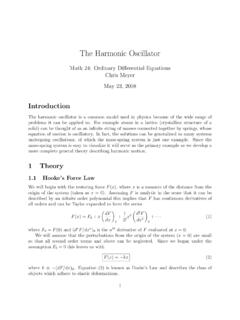

![arXiv:2112.07978v1 [quant-ph] 15 Dec 2021](/cache/preview/0/7/6/9/d/6/0/b/thumb-0769d60b3785b97adb6f78e38f482f6b.jpg)
